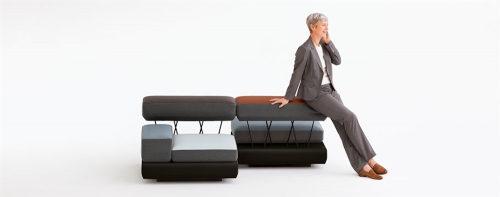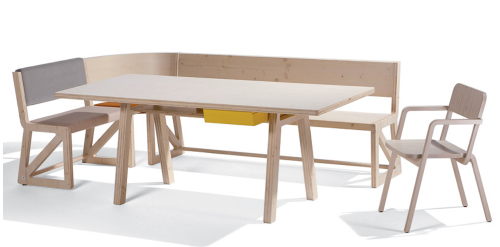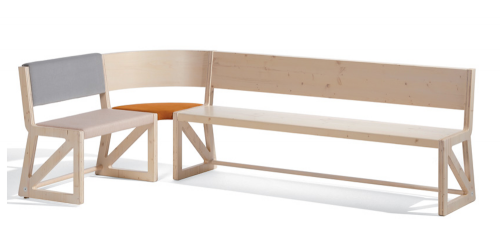 click > enlarge
click > enlarge
Berlin-based design group osko+deichmann recently released Plot, a padded, modular seating system for the contract market. Designed for Brunner, Plot is a versatile, customizable and easy to adjust lounge system “inspired by cascaded formations in nature.” Intended for use in hotels, lobbies and airports, the system is made up of add-on units that come in three height levels – low, medium and high. The base level acts as a low-lying side table to hold purses, drinks, etc. The medium level cushions act as seats and can be raised to the next highest level to form seat backs, arm rests and area dividers. The color-blocked units make this system much more attractive than your average contract commercial seating, too. Watch this short video to see how Plot can grow or shrink to fit your space.
From Brunner:
How do we sit down while we’re travelling? Do we wait or do we work? Do we meet other people and communicate? Do we take a time-out and relax ? How private do we want to be in public spaces?
plot from Berlin-based designer duo osko+deichmann provides a contemporary response to these questions. Building on a square base module with variable seating surfaces at three levels, plot fully reinterprets the roles of arm-rests and back-rests.
Every person uses furniture in their own unique way. While sitting down, people change their posture and furniture serves a different purpose for each of us – for some it offers a spot to rest or communicate while for others it provides a temporary office space or an oasis of tranquillity. With its multilevel seating, plot allows different seating positions and encourages informal communication. plot, the modular loungescape invites people to return and interpret seating in a new way.

about perrin drumm

German designer Alexander Seifried named his latest furniture collection Stijl after De Stijl, the Dutch art and design movement that advocated “pure abstraction and universality by a reduction to the essentials of form and color.” Traditionally De Stijl-ers focused on vertical and horizontal lines and used only primary colors in addition to black and white. That’s a bit limiting, and though I appreciate the rigors of De Stijl, black, blue, red and yellow furniture doesn’t exactly assimilate very well into too many homes nowadays.
Fortunately, Seifried didn’t think so either. His Stijl collection updates white to include raw birch wood and black to include shades of gray. Added bonus? It’s something of a BIY (build-it-yourself) unit. The main component is a desk with a bright yellow drawer. When you add any combination of the chair, seat, bench and corner bench piece, it becomes a dining table. If you buy two of each seating elements you get a full circle of seats. What’s Dutch for wunderbar? (Okay, I couldn’t help looking it up: prachtig!)



about perrin drumm

Prefabricated architecture makes its way to the top of the Italian alps with the Alpine Pod, located on the Freboudze glacier on the Mont Blanc range. Commissioned by the Italian pine club, CAI Torino, the pod offers climbers refuge from the terrain’s severe conditions.
Designed and built by LEAPfactory, “an Italian firm specializing in modular structures with low environmental impact,” the Alpine Pod uses nautical and aeronautical fabrication techniques to create a self-sufficient structure capable of withstanding extreme weather, like 124 mph winds and 26 feet of snow.
Nothing like this has ever been attempted before, and as such it looks nothing like typical alpine structures. Luca Olivari, the project’s structural engineer, used glass-fiber reinforced plastic (GFRP), which he said is “an ideal material for extreme conditions because the fiber’s weight and orientation can be precisely defined in every area of the structure to support high-concentrated loads.”
As for the pod’s features, it’s 250 square-feet and has a kitchen as well as dining and living areas, twelve bunks, storage for gear and a weather monitoring station. Photovoltaic panels produce 2.5 Kwh of solar energy; It weighs almost 3 tons and cost about $327,000 to construct. And because it’s based on a modular structure, with “individual modules designed for specific functions like eating or sleeping,” the pod itself can actually be rearranged and expanded, should demand require it.
It’s an amazing feat of specialized building under extreme conditions. I’m anxious to follow this project to see how the pod functions after months of wear. But even if the cute sweater design gets rubbed out by wind and sleet, it’s still an oasis in a frozen, forbidding landscape for adventurers heading into the alps on foot.





about perrin drumm
 click > enlarge
click > enlarge










